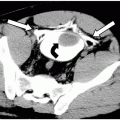Retained Products of Conception
Laura Amodei
Retained products of conception (RPOC) can be a troublesome complication of spontaneous or induced abortion and childbirth. The retained tissue can cause persistent bleeding, pain, and endometritis. However, overdiagnosis should be avoided because the standard treatment is curettage, which itself is associated with potential complications, including cervical laceration, uterine perforation, and uterine synechiae—in up to 7% of cases. There are also potential complications from the required anesthesia.
Clinial History and Presentation.
RPOC can occur after spontaneous or induced abortion, transvaginal delivery, or cesarean section, and can be discovered as late as several months after delivery. Common presenting complaints include persistent postpartum vaginal bleeding, pelvic pain, and fever. These symptoms are nonspecific and can also be seen after a normal delivery. Patients may have anemia due to persistent bleeding or leukocytosis in the setting of superimposed infection. Physical examination is not reliable for detection of RPOC.
Indication.
Ultrasonography is the modality of choice for evaluation of RPOC.
Technique.
In the patient who is immediately postpartum, transabdominal imaging may be adequate, although endovaginal imaging can generally be tolerated and should be performed. In the patient who is postabortion or who is in the later postpartum period, endovaginal ultrasonography adds to the sensitivity of transabdominal imaging and should always be performed. A few studies have suggested that hysterosonography may help distinguish between blood clots and RPOC but this is not yet standard of care.




